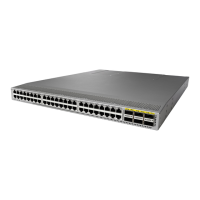Send document comments to nexus3k-docfeedback@cisco.com
10-9
Cisco Nexus 3000 Series NX-OS Unicast Routing Configuration Guide, NX-OS Release5.0(3)U1(1)
Chapter 10 Managing the Unicast RIB and FIB
Managing the Unicast RIB and FIB
Estimating Memory Requirements for Routes
You can estimate the memory that a number of routes and next-hop addresses will use.
To estimate the memory requirements for routes, use the following command in any mode:
Clearing Routes in the Unicast RIB
You can clear one or more routes from the unicast RIB.
Caution The * keyword is severely disruptive to routing.
To clear one or more entries in the unicast RIB, use the following commands in any mode:
Command Purpose
show routing memory estimate routes
num-routes
next-hops
num-nexthops
Example:
switch# show routing memory estimate
routes 1000 next-hops 1
Displays the memory requirements for routs. The
num-routes range is from 1000 to 1000000. The
num-nexthops range is from 1 to 16.
Command Purpose
clear ip route {* | {
route
|
prefix/length
}[
next-hop
interface
]}
[vrf
vrf-name
]
Example:
switch(config)# clear ip route
10.2.2.2
Clears one or more routes from both the unicast RIB and
all the module FIBs. The route options are as follows:
• *—All routes.
• route—An individual IP route.
• prefix/length—Any IP prefix.
• next-hop—The next-hop address
• interface—The interface to reach the next-hop
address.
The vrf-name can be any case-sensitive, alphanumeric
string up to 32 characters.
clear routing [multicast | unicast]
[ip | ipv4] {* | {
route
|
prefix/length
}[
next-hop
interface
]}
[vrf
vrf-name
]
Example:
switch(config)# clear routing ip
10.2.2.2
Clears one or more routes from the unicast RIB. The
route options are as follows:
• *—All routes.
• route—An individual IP route.
• prefix/length—Any IP prefix.
• next-hop—The next-hop address
• interface—The interface to reach the next-hop
address.
The vrf-name can be any case-sensitive, alphanumeric
string up to 32 characters.

